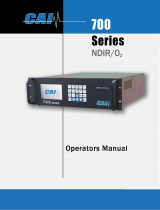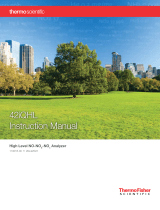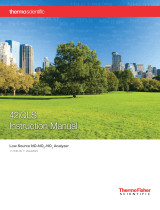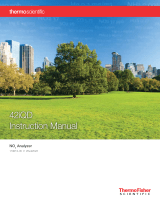Page is loading ...

R
R
o
o
s
s
e
e
m
m
o
o
u
u
n
n
t
t
A
A
n
n
a
a
l
l
y
y
t
t
i
i
c
c
a
a
l
l
M
M
i
i
c
c
r
r
o
o
C
C
E
E
M
M
T
T
S
S
A
A
n
n
a
a
l
l
y
y
s
s
i
i
s
s
E
E
n
n
c
c
l
l
o
o
s
s
u
u
r
r
e
e
Micro Continuous Emission Monitor
Operation & Maintenance Manual
Revision 2.36, July 1, 2004
Part Number 1021021-100
Rosemount Analytical UCEM Continuous Analyzer Transmitter

CONTENTS
Preface
Intended Use Statement …………………………………………………………………………….. 1
Safety Summary ……………………………………………………………………………………… 1
Specifications – Analysis Enclosure: General …………………………………………………….. 4
Specifications – Probe/Sample Handling Enclosure: General ..………………………………… 5
Customer Service, Technical Assistance and Field Service ………..………………………….. 6
Returning Parts to the Factory………………………………………………………………………. 6
Training ………………………………………………………………………………………………... 7
1. Introduction......................................................................... 1–3
1.1 Overview..........................................................................................................................1–3
1.2 Time Shared Option.........................................................................................................1–5
1.3 Theory of Operation.........................................................................................................1–7
1.3.1 NOx..................................................................................................................................1–7
1.3.2 CO ...................................................................................................................................1–7
1.3.3 O2....................................................................................................................................1–8
1.3.4 SO2..................................................................................................................................1–9
2. Detector Methodologies..................................................... 2–1
2.1 Non-Dispersive Infrared (NDIR).......................................................................................2–1
2.1.1 Interference Filter Correlation Method.............................................................................2–1
2.1.2 Opto-Pneumatic Method..................................................................................................2–2
2.1.3 Overall NDIR Method.......................................................................................................2–4
2.2 Paramagnetic Oxygen Method........................................................................................2–5
2.3 Electrochemical Oxygen Method.....................................................................................2–6
3. Installation........................................................................... 3–1
3.1 Specifications...................................................................................................................3–1
3.2 Process and Calibration Gas Connection........................................................................3–9
3.2.1 Gas Conditioning...........................................................................................................3–10
3.3 Installation........................................................................................................................3–1
3.3.1 Location...........................................................................................................................3–1
3.3.2 Limitations........................................................................................................................3–1
3.3.3 Mounting Options.............................................................................................................3–1
3.3.4 Electrical Connections.....................................................................................................3–1
3.3.4.1 Circular Connector Assembly Instructions.......................................................................3–3
3.3.4.2 EXT I/O Interface Connector ...........................................................................................3–4
3.3.4.3 SHU #1 / #2 Interface Connector.....................................................................................3–6
3.3.4.4 COM Interface Connector................................................................................................3–7
3.3.4.5 Lan Interface Connector..................................................................................................3–1
3.3.4.6 CPU I/O Interface Connector...........................................................................................3–1
3.3.4.7 SSU Power Connector, T/S units Only............................................................................3–2
3.3.4.8 AC Power Connector.......................................................................................................3–2
3.3.5 Analytical Leak Check .....................................................................................................3–3
3.3.5.1 Flow Indicator Method .....................................................................................................3–1
3.3.5.2 Manometer Method..........................................................................................................3–1
3.3.5.3 Troubleshooting Leaks ....................................................................................................3–3
4. Startup and Operation.........................................................4-1
4.1 Startup Procedure............................................................................................................ 4-1
Rosemount Analytical µCEM Continuous Analyzer Transmitter 2

CONTENTS
4.2 Analyzer Operation.......................................................................................................... 4-2
4.2.1 User Interface (Pocket PC Connection and Program Restore)........................................4-2
4.2.2 µCEM Main Window.........................................................................................................4-3
4.2.3 µCEM Menus............................................................................................................... 4-5
4.2.4 µCEM Alarms................................................................................................................... 4-7
4.2.5
µ
CEM Login......................................................................................................................4-9
4.2.6 µCEM Login-Current User Indication..............................................................................4-10
4.2.7 Stream Switching Control...............................................................................................4-11
4.3 µCEM Settings............................................................................................................... 4-12
4.3.1 µCEM Settings-Range....................................................................................................4-12
4.3.2 µCEM Settings-Auto Calibration.....................................................................................4-14
4.3.3 µCEM Settings - Auto Calibration Time and Frequency.................................................4-15
4.3.4 µCEM Settings-Limits ..................................................................................................4-175
4.3.5 µCEM Settings-Calibration Gas....................................................................................4-196
4.3.6
µCEM Settings-Maintenance Mode 4-
1918
4.3.7 µCEM Settings-Manual Calibration.............................................................................4-2018
4.3.8 µCEM Settings-Auto Calibration Dialog .....................................................................4-1619
4.4 µCEM Administration....................................................................................................... 4-2
4.4.1 µCEM Administration-User Settings.................................................................................4-2
4.4.2 µCEM Administration-Auto Logoff ....................................................................................4-3
4.5 µCEM Factory and User Settings.................................................................................... 4-4
4.6 uCEM Data Logs ............................................................................................................. 4-7
4.6.1 Maximum Log File Size ....................................................................................................4-7
4.6.2 Maximum Number of Log Files.........................................................................................4-7
4.6.3 Log File Name Format......................................................................................................4-7
4.6.4 Measurement Log File Format..........................................................................................4-8
4.6.5 Calibration Log File Format ..............................................................................................4-8
4.6.6 Alarm Log File Format....................................................................................................4-10
4.6.7 Accessing the Real-Time ACSII Data String via Ethernet TCP/IP (DAS).....................4-101
4.7 Viewing µCEM Data and Diagnotics with the Pocket PC Web Browser..........................4-1
4.8 Viewing µCEM Data with a Web Browser........................................................................ 4-1
4.8.1 Real-Time Page................................................................................................................4-3
4.8.2 Emissions Page................................................................................................................4-4
4.8.3 Download Page ................................................................................................................4-7
4.9 Viewing µCEM Data with MS Excel................................................................................. 4-8
4.10 Auto Calibration............................................................................................................... 4-1
5. Maintenance and Service....................................................5-1
5.1 Overview.......................................................................................................................... 5-1
5.2 Converter......................................................................................................................... 5-2
5.3 Ozonator.......................................................................................................................... 5-2
5.4 Personality Modules ........................................................................................................ 5-2
5.5 Detector Assembly........................................................................................................... 5-3
5.6 Central Processing Unit................................................................................................... 5-6
5.6.1.1 Features........................................................................................................................... 5-6
5.6.1.2 EMBEDDED ENHANCED BIOS:..................................................................................... 5-7
5.6.2 Analog/Digital I/O Board...................................................................................................5-7
5.6.2.1 Automatic Calibration....................................................................................................... 5-8
5.6.2.2 Analog Inputs................................................................................................................... 5-8
5.6.2.3 Programmable Input Ranges........................................................................................... 5-9
5.6.2.4 Enhanced Trigger and Sampling Control Signals............................................................ 5-9
5.6.2.5 Analog Outputs................................................................................................................ 5-9
5.6.2.6 FIFO and 16-Bit Bus Interface......................................................................................... 5-9
Rosemount Analytical µCEM Continuous Analyzer Transmitter 3

CONTENTS
5.6.2.7 Specifications................................................................................................................. 5-10
5.6.3 PCMCIA Adapter............................................................................................................5-11
5.6.3.1 Features......................................................................................................................... 5-12
5.6.3.2 SOFTWARE FEATURES:............................................................................................. 5-12
5.6.4 Modem............................................................................................................................5-12
5.6.4.1 Features......................................................................................................................... 5-13
5.6.5 Flash Drive........................................................................................................................5-1
5.6.5.1 Specifications................................................................................................................... 5-1
5.6.6 Pocket PC.........................................................................................................................5-1
5.6.7 Wireless LAN Adapter ......................................................................................................5-2
5.6.8 500 Watts Power Supply ..................................................................................................5-3
5.6.8.1 FEATURES...................................................................................................................... 5-3
5.7 Replacement Parts.......................................................................................................... 5-4
5.7.1 Replacement Part list........................................................................................................5-4
5.8 System Enclosure............................................................................................................ 5-9
5.9 Trouble LED................................................................................................................... 5-10
6. µCEM Software ....................................................................6-1
6.1 µCEM User Interface Software........................................................................................ 6-1
6.2 µCEM Web Server Software............................................................................................ 6-1
6.3 Software Development Management .............................................................................. 6-2
6.4 µCEM Pocket PC Connection Failure.............................................................................. 6-3
Rosemount Analytical µCEM Continuous Analyzer Transmitter 4

PREFACE
PREFACE
I
NTENDED USE STATEMENT
The µCEM Continuous Emission Monitoring Gas Analyzer is intended for use as an
industrial process measurement device only. It is not intended for use in medical,
diagnostic, or life support applications, and no independent agency certifications or
approvals are to be implied as covering such applications.
SAFETY SUMMARY
DANGER is used to indicate the presence of a hazard which will cause severe
personal injury, death, or substantial property damage if the warning is ignored.
WARNING is used to indicate the presence of a hazard which can cause severe
personal injury, death, or substantial property damage if the warning is ignored.
CAUTION is used to indicate the presence of a hazard which will or can cause minor
personal injury or property damage if the warning is ignored.
NOTE IS USED TO INDICATE INSTALLATION, OPERATION, OR MAINTENANCE INFORMATION
WHICH IS IMPORTANT BUT NOT HAZARD RELATED
.
DANGER: ALL PERSONNEL AUTHORIZED TO INSTALL,
OPERATE AND SERVICE THIS EQUIPMENT
To avoid explosion, loss of life, personal injury and damage to this equipment
and on-site property, do not operate or service this instrument before reading
and understanding this instruction manual and receiving appropriate training.
Save these instructions.
If this equipment is used in a manner not specified in these instructions,
protective systems may be impaired.
WARNING: DEVICE CERTIFICATION(S)
Any addition, substitution, or replacement of components installed on or in this
device, must be certified to meet the hazardous area classification that the
device was certified to prior to any such component addition, substitution, or
replacement. In addition, the installation of such device or devices must meet
the requirements specified and defined by the hazardous area classification of
the unmodified device. Any modifications to the device not meeting these
requirements, will void the product certification(s).
Rosemount Analytical µCEM Continuous Analyzer Transmitter 1

PREFACE
WARNING: POSSIBLE EXPLOSION HAZARD
+
WARNING: ELECTRICAL SHOCK HAZARD
POSSIBLE EXPLOSION HAZARD
DANGER: TOXIC GAS
WARNING: TOXIC GAS
This device may contain explosive, toxic or unhealthy gas components. Before
cleaning or changing parts in the gas paths, purge the gas lines with ambient air
or nitrogen.
Do not open while energized. Do not operate without dome and covers secure.
Installation requires access to live parts which can cause death or serious injury.
For safety and proper performance this instrument must be connected to a
properly grounded three-wire source of power.
Ensure that all gas connections are made as labeled and are leak free. Improper
gas connections could result in explosion and death.
This unit’s exhaust may contain hydrocarbons and other toxic gases such as
carbon monoxide. Carbon monoxide is highly toxic and can cause headache,
nausea, loss
of consciousness, and death.
Avoid inhalation of the exhaust gases at the exhaust fitting.
Connect exhaust outlet to a safe vent using stainless steel or Teflon line. Check
vent line and connections for leakage.
Keep all tube fittings tight to avoid leaks. See Section 3.3.5 for leak test
information.
WARNING: ELECTRICAL SHOCK HAZARD
Rosemount Analytical µCEM Continuous Analyzer Transmitter 2

PREFACE
WARNING: PARTS INTEGRITY AND UPGRADES
Tampering with or unauthorized substitution of components may adversely
affect the safety of this instrument. Use only factory approved components for
repair.
Because of the danger of introducing additional hazards, do not perform any
unauthorized modification to this instrument.
Return the instrument to a Rosemount Analytical Service office for service or
repair to ensure that safety features are maintained.
CAUTION: PRESSURIZED GAS
This unit requires periodic calibration with a known standard gas. It also may
utilize a pressurized carrier gas, such as helium, hydrogen, or nitrogen. See
General Precautions for Handling and Storing High Pressure Gas Cylinders at the
rear of this manual.
CAUTION: HEAVY WEIGHT
U
SE TWO PERSONS OR A SUITABLE LIFTING DEVICE TO MOVE OR
CARRY THE INSTRUMENT
.
Rosemount Analytical µCEM Continuous Analyzer Transmitter 3

PREFACE
SPECIFICATIONS – GENERAL
SPECIFICATIONS – Analysis Enclosure: GENERAL
Power: Universal Power Supply 85 – 125 VAC, 50 – 60 Hz, + 10%, 1000 Watts
Maximum at Start Up. 500 Watts Nominal
MicroProcessor: Intel Celeron processor, 566MHz, 64MB RAM, PC/104 architecture,
Windows NT embedded Platform
Pocket PC: 206MHz, StrongArm processor, 32MB RAM 32 ROM, 240 X 320 pixels LCD,
TFT color, backlit, Wireless LAN optional
Detectors//Number: NDIR (CO), UV (SO2), Paramagnetic (O2), Electrochemical (O2),
Chemiluminscent (NOx) // Up to three in one analyzer
Mounting: Wall Mount
Area Classification: General Purpose / NEMA 4X Fiberglass Enclosure Compliant
Compliance's: CSA (Pending)
Ambient Temperature Range: -30
0
to 50
0
Celsius.
Relative Humidity: 5 to 99%
Inputs/Outputs: The complete I/O list with terminal locations is located in section
3.3.4
Digital:
RS-485 Serial Port. (Multi-Drop Network)
RS-232 Serial Port.
LAN, Ethernet 10/100-BaseT
Connectivity Protocols:
HTML (Web Browser) – Status, file transfer Modem / Web browser
TCP/IP, MTTP ASCII String
Microsoft Shared drive
FTP Logs download
TELNET Server
Rosemount Analytical µCEM Continuous Analyzer Transmitter 4

PREFACE
Analog:
Analog Outputs: Qty. 3 Isolated 4-20 mA dc, 500 ohms Max Load (O2, CO or SO2,
NOx)
*Optional: Additional Qty. 3 (Extended I/O option)
Analog Inputs: Qty 2 (Typically; MW, Fuel Flow)
*Optional: Additional Qty. 2 (Extended I/O option)
Digital
Outputs:
Following are connected directly to the MicroCEM Probe/Sample Handling Box:
Sample Pump on/off, Drain Pump on/off, Purge on/off, Calibrate on/off – All are rated
110VAC @ 1amp Dry Contact.
Qty. 6 dry contact digital Outputs
*Optional Time Share option – Dry Contact used for Stream Indicator.
Digital Inputs:
Qty. 3: (Typical Process on/off, Flame Detect, Shutdown or Initiate Cal)
*Optional three additional Inputs (Extended I/O)
Instrument Weight: 62 lbs Typical
Size: 24“ X 20“ X 12“ (H W D)
Ranges:
O2: 0 –2 Selectable to 0 –25% (1% increments)
CO: 0 –100ppm Selectable to 1000ppm (1ppm increments)
NOx: 0 – 10ppm Selectable to 1000ppm (1ppm increments)
Sample Temperature: 0 degrees C to 55 degrees C
Sample flow rate: .5 to 1.5 liters/min
Warm Up Time: Max 25 minutes @ low ambient temperatures
Paramagnetic
O
2
)
Electro
Chemical O
2
NDIR
CO
Chemiluminescent
NOx
Linearity
<+/- 1% < +/- 1% < +/- 1% < +/- 1%
(1)
Zero Drift
< +/- 1% /day < +/- 1% /day < +/- 1% /day < +/- 1% /day
(1)
Span Drift
< +/- 1% /day < +/- 1% /day < +/- 1% /day < +/- 1% /day
(1)
Repeatability
< +/- 1% < +/- 1% < +/- 1% < +/- 1%/day
(1)
Response Time (t
90
)
10< +/-t
90
< +/-15 10< +/-t
90
< +/-15
15s< +/-t
90
< +/-
30s
15s< +/-t
90
< +/-30s
Influence of Ambient
Temperature
(-20C to 45C)
-On Zero
-On Span
< +/-1%
< +/-1%
< +/-1%
< +/-1%
< +/-2%
< +/-2%
< +/-2%
< +/-2%
(1)
0-10ppm NOx range is <+/- 3%.
Rosemount Analytical µCEM Continuous Analyzer Transmitter 5

INTRODUCTION
SPECIFICATIONS – Probe/Sample Handling Enclosure: GENERAL
See separate SHS manual for more details
Power: Universal Power Supply 85 – 125 VAC, 50 – 60 Hz, + 10%
750 Watts Maximum at Start Up. 500 Watts Nominal
Mounting: Customer Flange Mount (2 Hole Top) or Wall Mount for High Temp Option
Area Classification: General Purpose / NEMA 4X Fiberglass Enclosure
Compliance's: CSA (Pending)
Ambient Range Temperature: -30
0
to 50
0
Celsius
Relative Hum: 5 to 99%
Instrument Weight: 95 lbs Typical
Size: 24“ X 34“ X 12“ (H W D)
Stack Sample Moisture: Up to 25% max
Sample Cooler: Thermo Electric dual pass Chiller. Permeation Tube (-30 degrees C.
Dewpoint. Customer instrument air required @ 5 L/M, -40 degree C dewpoint
Max. Stack Temperature: Standard 400
0
F.
Optional: 600 F (available with elongated spool option)
High Temp: 1400 F (Off Stack Option)
Stack Pressure: Typical -5 to 15 inches H
2
O
Sample Flow Rate: 500 to 2500cc/min
Response Time: Maximum distance between Analysis Enclosure and Sample
Conditioning/Probe Enclosure is 300'. (Response time is 30 seconds/100' w/1/4"
tubing)..
Probe Length: 48" length 316 SS Probe with .5 micron sintered filter. Customer to cut
to length in field if necessary. Optional 5’ and 6’ probes.
Mounting Flange: Standard 4“ 150# Raised Face. Shipped Equipped with Gasket
Sample Pump: 316 SS diaphragm type
Instrument Air Requirements: Instrument grade air required. 15 SCFM @ 60 -100 PSIG (30
seconds 2 times per day) Pressure Regulation by Customer
Rosemount Analytical µCEM Continuous Analyzer Transmitter 1–1

INTRODUCTION
CUSTOMER SERVICE, TECHNICAL ASSISTANCE AND FIELD SERVICE
For order administration, replacement parts, application assistance, on-site or factory
repair, service or maintenance contract information, contact:
Rosemount Analytical Inc.
Process Analytical Division
Customer Service Center
1-800-433-6076
RETURNING PARTS TO THE FACTORY
Before returning parts, contact the Customer Service Center and request a Returned
Materials Authorization (RMA) number. Please have the following information when you
call: Model Number, Serial Number, and Purchase Order Number or Sales Order
Number.
Prior authorization by the factory must be obtained before returned materials will be
accepted. Unauthorized returns will be returned to the sender, freight collect.
When returning any product or component that has been exposed to a toxic, corrosive
or other hazardous material or used in such a hazardous environment, the user must
attach an appropriate Material Safety Data Sheet (M.S.D.S.) or a written certification
that the material has been decontaminated, disinfected and/or detoxified.
Return to:
Rosemount Analytical Inc.
1201 North Main St.
Orrville, OH 44667
USA
TRAINING
A comprehensive Factory Training Program of operator and service classes is
available. For a copy of the Current Operator and Service Training Schedule contact
the Technical Services Department at:
Rosemount Analytical Inc.
Phone: 1-330-682-9010
COMPLIANCES
This product may carry approvals from several certifying agencies. The certification
marks appear on the product name-rating plate.
NOTES
Rosemount Analytical µCEM Continuous Analyzer Transmitter 1–2

INTRODUCTION
1. Introduction
1.1 Overview
This manual describes the Rosemount Analytical Micro Continuous Emission
Monitoring (µCEM) gas Analyzer Module.
The µCEM Analyzer Module is designed to continuously determine the concentration of
O2, CO, SO2, and NOx in a flowing gaseous mixture. The concentration is expressed
in percent or parts-per-million.
The sampled gas is collected from the stack and prepared by the Probe/Sample
Handling Enclosure for analysis and processing by the Analysis Enclosure. The
ANALYSIS ENCLOSURE is a stand alone, computer-controlled unit, utilizing PC/104
as the system bus. The uCEM is enclosed in rugged NEMA 4X, IP65 type enclosures,
for harsh environment. The ANALYSIS ENCLOSURE utilizes convection cooling with
no air intake and air vents. The ANALYSIS ENCLOSURE is modular, general purpose
and easily expandable. It utilizes industry standard components such as PC/104
boards, and modular signal conditioning modules.
Rosemount Analytical µCEM Continuous Analyzer Transmitter 1–3

INTRODUCTION
Figure 1-1. µCEM Micro Continuous Emission Monitoring – Analysis Enclosure
Rosemount Analytical µCEM Continuous Analyzer Transmitter 1–4

INTRODUCTION
Figure 1-2. µCEM Micro Continuous Emission Monitoring Gas Analyzer with Time
Share option.
1.2 Time Shared Option
Provides the functionality to monitor and process sample gases from two streams on a
time-share scheme. This option allows you to connect one uCEM to two Sample
Handling units.
Rosemount Analytical µCEM Continuous Analyzer Transmitter 1–5

INTRODUCTION
TO SHU1
CAL GAS
CAL GAS
TO SHU2
SAMPLE
FROM SHU1
FROM SHU2
SAMPLE
EXHAUST
uCEM CAL
FROM
TO uCEM
SAMPLE
TV1
TV2
TV3
TV4
Figure 1-3. Time Share option Flow Diagram
Rosemount Analytical µCEM Continuous Analyzer Transmitter 1–6

INTRODUCTION
1.3 Theory of Operation
1.3.1 NOx
The NOx analyzer continuously analyzes a flowing gas sample for NOx [nitric oxide
(NO) plus nitrogen dioxide (NO
2
)]. The sum of the concentrations is continuously
reported as NOx.
The µCEM NOx Analyzer Module uses the chemiluminecence method of detection.
This technology is based on NO’s reaction with ozone (O
3
) to produce NO
2
and oxygen
(O
2
). Some of the NO
2
molecules produced are in an electronically excited state (NO
2
*
where the * refers to the excitation). These revert to the ground state, with emission of
photons (essentially, red light). The reactions involved are:
NO
2
+ O
3
→ NO
2
* + O
2
NO
2
* → NO
2
+ red light
The sample is continuously passed through a heated bed of vitreous carbon, in which
NO
2
is reduced to NO. Any NO initially present in the sample passes through the
converter unchanged, and any NO
2
is converted to an approximately equivalent (95%)
amount of NO.
The NO is quantitatively converted to NO
2
by gas-phase oxidation with molecular
ozone produced within the analyzer from air supplied by an external source. During the
reaction, approximately 10% of the NO
2
molecules are elevated to an electronically
excited state, followed by immediate decay to the non-excited state, accompanied by
emission of photons. These photons are detected by a photomultiplier tube which
produces an output proportional to the concentration of NOx in the sample.
To minimize system response time, an internal sample bypass feature provides high-
velocity sample flow through the analyzer.
1.3.2 CO
The optical bench can selectively measure multiple components in a compact design by using a
unique dual optical bench design. Depending on the application, any two combinations of NDIR
channels can be combined on a single chopper motor/dual source assembly.
Other application-dependent options include a wide range of sample cell materials, optical filters and
solid state detectors. The NDIR Microflow detector consists of two chambers, measurement and
reference with an interconnected path in which an ultra low flow filament sensor is mounted. During
operation, a pulsating flow occurs between the two chambers which is dependent upon: sample gas
absorption, modulation by the chopper motor and the fill gas of the detector chambers. The gas
flow/sensor output is proportional to the measured gas concentration. The optical bench is further
enhanced by a novel “Look-through” detector technique. This design allows two detectors to be
arranged in series --- enabling two different components to be measured on a single optical bench.
The optical bench contains a unique eddy current drive chopper motor and source assembly. This
design incorporates on board “intelligence” to provide continuous “self test” diagnostics.
Rosemount Analytical µCEM Continuous Analyzer Transmitter 1–7

INTRODUCTION
1.3.3 O2
Paramagnetic: The determination of oxygen is based on the measurement of the magnetic
susceptibility of the sample gas. Oxygen is strongly paramagnetic, while other common gases
are not. The detector used is compact, has fast response and a wide dynamic range. The long
life cell is corrosion resistant, heated and may be easily cleaned. It has rugged self-tensioning
suspension and is of welded Non-Glued construction.
Rosemount Analytical µCEM Continuous Analyzer Transmitter 1–8

INTRODUCTION
1.3.4 SO2
The optical bench can selectively measure multiple components in a compact design by using a
unique dual optical bench design. Depending on the application, any two combinations of NDIR
channels can be combined on a single chopper motor/dual source assembly.
Other application-dependent options include a wide range of sample cell materials, optical filters
and solid state detectors. The NDIR Microflow detector consists of two chambers, measurement
and reference with an interconnected path in which an ultra low flow filament sensor is mounted
during operation, a pulsating flow occurs between the two chambers which is dependent upon:
sample gas absorption, modulation by the chopper motor and the fill gas of the detector
chambers. The gas flow/sensor output is proportional to the measured gas concentration. The
optical bench is further enhanced by a novel “Look-through” detector technique. This design
allows two detectors to be arranged in series --- enabling two different components to be
measured on a single optical bench. The optical bench contains a unique eddy current drive
chopper motor and source assembly. This design incorporates on board “intelligence” to provide
continuous “self test” diagnostics.
Rosemount Analytical µCEM Continuous Analyzer Transmitter 1–9

Detector Methodologies
2. Detector Methodologies
The µCEM can employ up to three different measuring methods depending on the
configuration chosen. The methods are: NDIR CO/SO2, Paramagnetic O
2
,
Electrochemical O
2
, and chemiluminescent NOx.
2.1 Non-Dispersive Infrared (NDIR)
The non-dispersive infrared method is based on the principle of absorption of infrared
radiation by the sample gas being measured. The gas-specific wavelengths of the
absorption bands characterize the type of gas while the strength of the absorption gives
a measure of the concentration of the gas component being measured.
An optical bench is employed comprising an infrared light source, two analysis cells
(reference and measurement), a chopper wheel to alternate the radiation intensity
between the reference and measurement side, and a photometer detector. The
detector signal thus alternates between concentration dependent and concentration
independent values. The difference between the two is a reliable measure of the
concentration of the absorbing gas component.
Depending on the gas being measured and its concentration, one of two different
measuring methods may be used as follows:
2.1.1 Interference Filter Correlation Method
With the IFC method the analysis cell is alternately illuminated with filtered infrared
concentrated in one of two spectrally separated wavelength ranges. One of these two
wavelength bands is chosen to coincide with an absorption band of the sample gas and
the other is chosen such that none of the gas constituents expected to be encountered
in practice absorbs anywhere within the band.
The spectral transmittance curves of the interference filters used in the µCEM analyzer
and the spectral absorption of the gases CO and CO
2
are shown in Figure 2-1 below. It
can be seen that the absorption bands of these gases each coincide with the
passbands of one of the interference filters. The forth interference filter, used for
generating a reference signal, has its passband in a spectral region where none of
these gases absorb. Most of the other gases of interest also do not absorb within the
passband of this reference filter.
The signal generation is accomplished with a pyroelectrical (solid-state) detector. The
detector records the incoming infrared radiation. This radiation is reduced by the
absorption of the gas at the corresponding wavelengths. By comparing the
measurement and reference wavelength, an alternating voltage signal is produced.
This signal results from the cooling and heating of the pyroelectric detector material.
Rosemount Analytical µCEM Continuous Analyzer Transmitter 2–1

DETECTOR METHODOLOGIES
Figure 2-1. Absorption Bands of Sample Gas and Transmittance of Interference Filters
2.1.2 Opto-Pneumatic Method
In the opto-pneumatic method, a thermal radiator generates the infrared radiation which
passes through the chopper wheel. This radiation alternately passes through the filter
cell and reaches the measuring and reference side of the analysis cell with equal
intensity. After passing another filter cell, the radiation reaches the pneumatic detector.
The pneumatic detector compares and evaluates the radiation from the measuring and
reference sides of the analysis cell and converts them into voltage signals proportional
to their respective intensity.
The pneumatic detector consists of a gas-filled absorption chamber and a
compensation chamber which are connected by a flow channel in which a Microflow
filament sensor is mounted. This is shown in Figure 2-2 below.
In principle the detector is filled with the infrared active gas to be measured and is only
sensitive to this distinct gas with its characteristic absorption spectrum. The absorption
chamber is sealed with a window which is transparent for infrared radiation. The
window is usually Calcium Fluoride (CaF
2
).
When the infrared radiation passes through the reference side of the analysis cell into
the detector, no pre-absorption occurs. Thus, the gas inside the absorption chamber is
heated, expands and some of it passes through the flow channel into the compensation
chamber.
Rosemount Analytical µCEM Continuous Analyzer Transmitter 2–2
/





